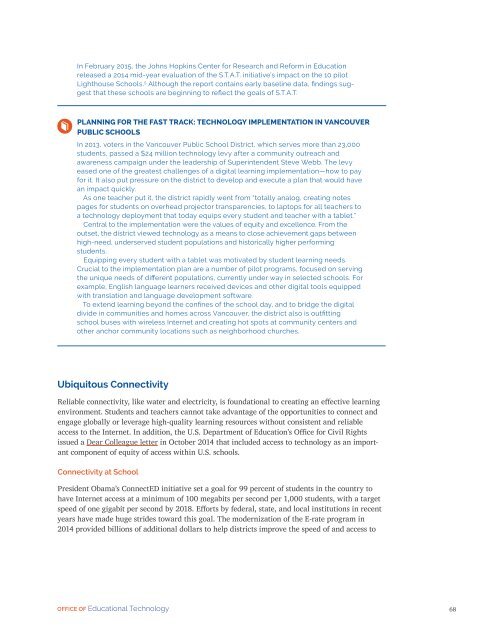Future Ready Learning
7m3sdJ
7m3sdJ
You also want an ePaper? Increase the reach of your titles
YUMPU automatically turns print PDFs into web optimized ePapers that Google loves.
In February 2015, the Johns Hopkins Center for Research and Reform in Education<br />
released a 2014 mid-year evaluation of the S.T.A.T. initiative’s impact on the 10 pilot<br />
Lighthouse Schools. 5 Although the report contains early baseline data, findings suggest<br />
that these schools are beginning to reflect the goals of S.T.A.T.<br />
PLANNING FOR THE FAST TRACK: TECHNOLOGY IMPLEMENTATION IN VANCOUVER<br />
PUBLIC SCHOOLS<br />
In 2013, voters in the Vancouver Public School District, which serves more than 23,000<br />
students, passed a $24 million technology levy after a community outreach and<br />
awareness campaign under the leadership of Superintendent Steve Webb. The levy<br />
eased one of the greatest challenges of a digital learning implementation—how to pay<br />
for it. It also put pressure on the district to develop and execute a plan that would have<br />
an impact quickly.<br />
As one teacher put it, the district rapidly went from “totally analog, creating notes<br />
pages for students on overhead projector transparencies, to laptops for all teachers to<br />
a technology deployment that today equips every student and teacher with a tablet.”<br />
Central to the implementation were the values of equity and excellence. From the<br />
outset, the district viewed technology as a means to close achievement gaps between<br />
high-need, underserved student populations and historically higher performing<br />
students.<br />
Equipping every student with a tablet was motivated by student learning needs.<br />
Crucial to the implementation plan are a number of pilot programs, focused on serving<br />
the unique needs of different populations, currently under way in selected schools. For<br />
example, English language learners received devices and other digital tools equipped<br />
with translation and language development software.<br />
To extend learning beyond the confines of the school day, and to bridge the digital<br />
divide in communities and homes across Vancouver, the district also is outfitting<br />
school buses with wireless Internet and creating hot spots at community centers and<br />
other anchor community locations such as neighborhood churches.<br />
Ubiquitous Connectivity<br />
Reliable connectivity, like water and electricity, is foundational to creating an effective learning<br />
environment. Students and teachers cannot take advantage of the opportunities to connect and<br />
engage globally or leverage high-quality learning resources without consistent and reliable<br />
access to the Internet. In addition, the U.S. Department of Education’s Office for Civil Rights<br />
issued a Dear Colleague letter in October 2014 that included access to technology as an important<br />
component of equity of access within U.S. schools.<br />
Connectivity at School<br />
President Obama’s ConnectED initiative set a goal for 99 percent of students in the country to<br />
have Internet access at a minimum of 100 megabits per second per 1,000 students, with a target<br />
speed of one gigabit per second by 2018. Efforts by federal, state, and local institutions in recent<br />
years have made huge strides toward this goal. The modernization of the E-rate program in<br />
2014 provided billions of additional dollars to help districts improve the speed of and access to<br />
OFFICE OF Educational Technology<br />
68



